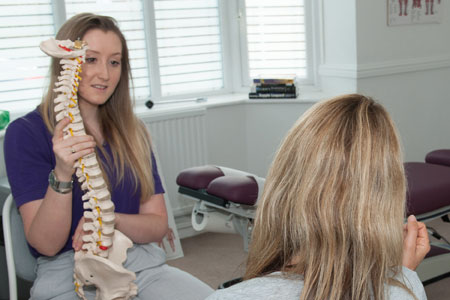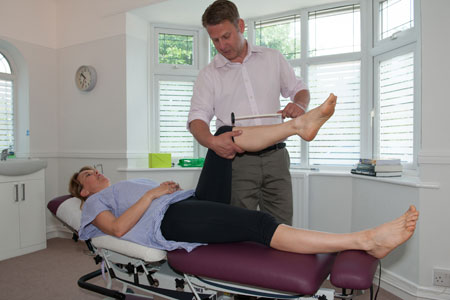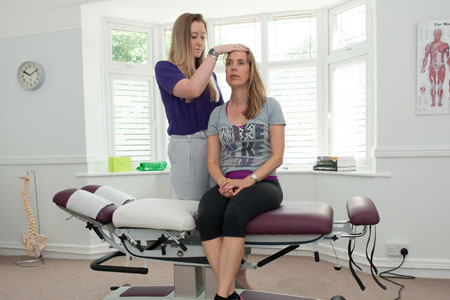
Chiropractic

Chiropractic is our core treatment at Back to Health.
Chiropractic is a primary health-care profession that specialises in the diagnosis, treatment and overall management of conditions that are due to problems with the joints, ligaments, tendons and nerves, especially related to the spine.
Conditions treated
Although chiropractors are best known for treating back and neck pain, patients also consult chiropractors regarding a range of other conditions. Chiropractors typically focus on, but are not limited to:
- Mid and lower back pain
- Neck pain
- Joint pain in the arms, legs and knees
- Lumbago
- Headache arising from the neck
- Migraine prevention
- Minor sports injuries
- Rotator cuff injuries
- Sciatica
- Shoulder complaints
- Tension and inability to relax
Chiropractic treatment mainly involves safe, often gentle, specific spinal manipulation to free joints in the spine or other areas of the body that are not moving properly. Apart from manipulation, chiropractors may use a variety of techniques including mobilisation, massage, ice & heat treatment, ultrasound, exercise, taping as well as advice about posture and lifestyle.
Most people might be surprised to find out that Chiropractors have to undertake a rigorous 4 or 5year programme of full time study to qualify with a Masters of Chiropractic. There are nearly 3000 chiropractors regulated by the GCC in the UK. The Chiropractic profession is regulated in the same way as medical doctors, dentists and nurses. The Chiropractic regulatory organisation is called the General Chiropractic Council (GCC). You have to be registered with the GCC to be able to call yourself a chiropractor.
What happens during the first visit? (Initial Assessment)
Good chiropractors do everything in their power to help relieve their patient’s symptoms as fast as possible with as few treatments as necessary. They also give advice on how to avoid future episodes of back pain. A first visit chiropractic consultation typically lasts between 45 and 60 minutes.
In preparation for the chiropractic consultation, a patient will be asked to provide background information about the symptoms and condition. The sort of questions your Chiropractor might ask whilst taking the medical history include:
- When and how did the pain start?
- Where is it located?
- Is it a result of an injury?
- Have you had it before?
- What activities/circumstances makes it better?
- What activities/circumstances makes it worse?
- What type of treatment have you had since it started (physiotherapy, medication, ice, heat, etc)
- How much is it effecting your daily activities? Can you work/drive/sleep?
Patients are also usually asked to provide information on family medical history, any pre-existing medical conditions or prior injuries, and previous and current health providers and treatments.
The Chiropractic examination

A thorough chiropractic exam includes general tests such as blood pressure, pulse, respiration, and reflexes, as well as specific orthopaedic and neurological tests to assess:
- Range of motion of the affected part
- Muscle tone
- Muscle strength
- Neurological integrity
Further chiropractic exam tests may be necessary to assess the affected area (such as having the individual move in a specific manner, posture analysis, or chiropractic manipulation of the affected body part).
Diagnostic tests
Based upon the results of the history and chiropractic exam, diagnostic tests may be helpful in revealing pathologies and identifying structural abnormalities that can be used by the chiropractor to more accurately diagnose a condition. Diagnostic studies are often not necessary during the chiropractic consultation.
The most common diagnostic tests following a chiropractic consultation could include:
- X-ray exam
- MRI (Magnetic Resonance Imaging) scan
- Blood tests
The chiropractor will refer you back to your GP if any of the above are needed. Back to Health also work alongside several local private providers of diagnostic tests.
Patient Diagnosis

The medical history, physical examination and any diagnostic studies lead to a specific diagnosis. Once the diagnosis is established, the chiropractor will determine if the condition will respond to chiropractic care. This part of the consultation is called the report of findings.
Your Chiropractor will explain:
- Diagnosed condition
- Individualised chiropractic treatment plan (or other treatments)
- Anticipated length of chiropractic care
In most cases the chiropractor will begin treatment during the patient’s first visit, although if certain diagnostic tests are needed it may be necessary to wait until the results are received.
Chiropractic treatment recommendations may include a combination of treatment techniques including:
- Manipulation and mobilisation to restore range of movement and correct joint dysfunction
- Methods for improving soft tissue healing & pain control, such as ultrasound, electrical stimulation, and medical acupuncture
- Exercises to improve muscle balance, strength and coordination
- Patient education to improve posture and motor control
- Other complimentary modalities such as massage, heat/cold application, and education on nutrition or talking therapies
Our Chiropractic team
We have the largest team of chiropractors in the North West as we are fortunate to have ten chiropractors working across our three clinics in Wrexham, Mold and Chester.
What happens at an IA (initial assessment)?
Up to 60 mins
Case History & Examination
- Review of symptoms & establish patient goals and targets
- Detailed case history & medical history
- Full examination including
Orthopaedic & neurological testing
- Specific chiropractic tests
- Functional movement screening
Report of Findings
- Overview of report of findings & diagnosis
Treatment
- Chiropractic treatment if clinically indicated
- Possible referral to GP or other relevant health professional if clinically indicated for x-ray, ultra sound or MRI
- Self-care advice to follow at home
What happens at a Follow up appointment?
Up to 20 mins
- A full explanation of what was found during the examination
- A diagnosis
- A full explanation of how we can help
- An outline of a treatment plan and how long we can expect it to take
- Confirmation of costs
- Chiropractic treatment
- Self-help advice
What happens during a Chiropractic Treatment appointment?
Approx 15 - 20 mins
- Review of recent symptoms & patient wellbeing
- Chiropractic & other appropriate treatment
- Self-help & rehabilitation guidance
What happens during a Chiropractic Reassessment appointment?
Approx 30 - 40 mins
- Review of symptoms & establish patient goals and targets
- Short examination including chiropractic tests
- Overview of report of examination findings
- Diagnosis
- Chiropractic treatment if clinically indicated
- Possible referral to GP or other relevant health professional
- Self-care advice
Goals of the Chiropractic Treatment Plan

The chiropractor will establish specific goals for a patient’s individual plan for treatment:
- Short-term goals include reducing pain and restoring normal joint function and muscle balanc
- Long-term goals include restoring functional independence and tolerance to normal activities of daily living
- Advice and regular treatment for prevention of recurrence in the future
To reach these goals, a specific number of chiropractic visits will typically be prescribed.
A typical evidence-based treatment plan for treating a recent case of acute, mechanical low back pain would be 2 visits per week for 2 weeks followed by 1 visit per week for another 2 weeks. The treatment plan would include re-examination and reviews at regular intervals throughout the visits. If the episode of back pain is reoccurring or has been there for a long time the treatment plan may well be different. A typical example could be a weekly visit for 6 weeks followed by a review and continued weekly or bi-weekly visits until a significant improvement can be seen. Once they are out of pain some of our patients benefit from MOT care so that they remain pain- free. This may involve a monthly or a 3 monthly maintenance visit.
A typical chiropractic treatment at Back to Health will take 15 - 20 minutes. It is important to recognise that the fees are a recognition of the expertise of the chiropractor and not for the time being treated (like a dentist!). Each patient is given exactly the right amount of treatment time to correct their problem. During each visit, the chiropractor will usually make small manipulations to the joints of the spine, sometimes causing a slight popping noise to be heard. The treatment is usually painless, but some people experience a temporary increase in their symptoms, stiffness or tiredness. Massage, exercise prescription and stretching are routinely used in the management. There is a large emphasis on self-help, home exercise and lifestyle advice.
At certain points in the treatment plan the Chiropractor will measure the response to treatment and determine whether to:
- Continue chiropractic treatment if appropriate
- Release the patient from chiropractic care if treatment goals have been met
- Refer the patient to another health care specialist if treatment goals have not been fulfilled
Chiropractic care and the NHS
Nearly all chiropractors work as private health care providers although some NHS trusts do provide chiropractic care. Most of our patients self-refer for treatment. We do receive referrals from GP’s for treatment but in most cases the patient pays for their own care. Back to Health are currently lobbying the local Health Board and NHS trust to extend their musculoskeletal services to include chiropractic care. If you have experienced excellent results from the chiropractic care you have received please let your GP know!
Current NICE guidelines for the treatment of chronic low back pain recommended the use of chiropractic and physiotherapy - manipulation, mobilisation and massage to treat low back pain. Back to Health follow NICE best practice guidelines for all of treatment plans. Please reassure your GP that they can refer to chiropractors in the same way as they would refer to a private consultant. If your GP would like some more information about the work, please let us know and we can arrange to send information to them or arrange a meeting.
How are chiropractors regulated?
Chiropractic is regulated in the same way as medical doctors and dentists. It is a statutorily regulated healthcare profession governed by the General Chiropractic Council (www.gcc.gov.uk).
In addition to being regulated by the GCC, each chiropractor is required to be represented by a professional association. Back to Health chiropractors are members of the British Chiropractic Association, founded in 1925 (www.chiropractic-uk.co.uk) and the United Chiropractic Association UCA (www.united-chiropractic.org). Together they represent most chiropractors in the UK. As members of the BCA and the UCA they must abide by the GCC Code of Conduct and Standard of Proficiency.
The GCC only accepts graduates who have gone through a minimum four-year full-time internationally accredited degree course at a recognised college of chiropractic education.
Insurance cover
Chiropractic care is covered by all the major private medical insurers. Each insurance policy is individual, and we would ask all patients to check with their insurer on how to access chiropractic care.
We ask patients to bring a copy of their insurance policy along to their first visit at the clinic so that we can check the amount of coverage and whether an excess is payable.
Testimonials
Brilliant! Thanks to Back to Health I am sleeping better & I actually feel as if I’m 25 and not 100 years old
Wrexham chiropractic patient 6806
It was an instant relief from the first session. You really fixed me. I feels as if it never happened now. Thank you so much for your help
Jackie, Wrexham chiropractic patient
I’ve seen a marked improvement after each session. The exercises I have been given have also made a massive difference
Mold patient 296
Did you know?
We celebrated our 10-year anniversary in Wrexham last year. Our patient survey revealed that the top 6 jobs which seemed to cause bad backs were Healthcare, Teachers, Hairdressers, Office based workers, Tradesmen & women, Retirees and Drivers





